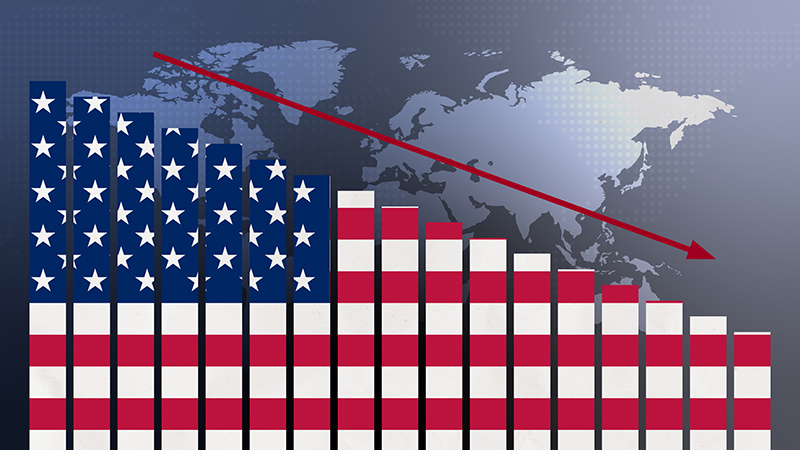The S&P 500 index hit official bear market territory last week and speculation quickly turned to when markets might have reached the point of ‘capitulation’. This is the magical moment when the sellers evaporate and early, brave buyers start to emerge. It is the moment when a new bull market begins, but are there signs this is happening today?
Capitulation has no official definition. Analysts tend to look at a series of measures to judge whether markets are close to a tipping point. These include market volatility, valuation and sentiment indicators, plus economic indicators. Taken in aggregate, they paint a picture of whether the bad news is already in market prices.
The Vix index is one element in judging whether a capitulation point has been hit. Capitulation usually occurs when volatility is higher. It suggests investors may be panic-selling out of stocks and, therefore, that the market is hitting its nadir. The Vix is certainly higher than it has been in recent history, but is nowhere near its global financial crisis or pandemic peaks.
Laith Khalaf, head of investment analysis at AJ Bell, says this measure of fear or greed among investors is not at extreme levels: “The index currently sits at 26, which is above the long-run average reading of 20, but significantly below the readings of over 50 we saw in 2008 and 2020. So market anxiety is elevated, but it is certainly not at fever pitch, which suggests this is not a moment of extreme fear which should prompt investors to be excessively greedy.”
Complicated picture for equities
Fund flow data is perhaps more encouraging, at least when it comes to bonds. Bank of America (BofA) research shows investors have sold $193bn of bonds for the year to date, suggesting much of the bad news on interest rates and inflation may already be reflected in prices. The picture for equities is more complicated.
While investors have bought $195bn of stocks since January, equity outflows have been accelerating in recent weeks and BofA private clients now have their lowest allocations to stocks since November of 2020.
The most recent, much-watched American Association of Individual Investors survey of investor sentiment shows that fear among private investors is now higher than it was during the financial crisis and only just below the level when the Gulf war started. This is particularly important in areas such as technology, where private investor involvement has been crucial in driving share prices higher.
However, Charles-Henry Monchau, chief investment officer at Banque Syz, sounds a note of caution: “While sentiment indicators point to an oversold market, other evidence suggests that we have not yet seen a true sell-off. Retail investors continue to invest heavily in Ark Invest ETFs, icons of the previous bull market, despite their steep declines.”
Valuations also do not present a clear-cut picture. They are cheaper than they were a few months ago, but this needs to be put into context.
Monchau says: “Multiples as a whole have returned to the median levels of their 20-year history. We are therefore not yet at an undervalued level.
“Secondly, a downward revision of earnings can still occur in the second half of the year. Finally, equity markets are now competing with other asset classes: for example, bonds have seen their yields rise in recent months and are now considered as an attractive investment again by some asset allocators.”
Anthony Willis, investment manager on the BMO GAM multi-manager people team, is also worried about earnings: “Market attention will soon turn to second quarter earnings season and the focus will be on signs of earnings slowing. So far in this sell off, market prices have moved lower, but earnings expectations remain stubbornly high. If we are headed for recession, these expectations need to come down. This would likely set in place another leg lower for equity markets.”
Divergent fortunes
Is it possible that some parts of the market have capitulated rather than the market as a whole? The obvious area would be technology.
Paul Quinsee at JP Morgan Asset Management, points out in the group’s most recent Global Equity Views: “The Nasdaq market has lost nearly $6trn in market capitalisation from its peak, a 24% decline (that compares with a 65% decline in the 1999-2000 period). A third of the stocks now listed on Nasdaq have plunged 75% or more from their highs. The group of “not yet profitable” companies that we monitor worldwide has now underperformed by 51% since the end of 2020, after 81% relative gains in the previous two years.”
The question is whether these dramatic declines correct earlier excesses. He points out that the gap in valuations between high and low priced growth stocks remains almost as wide as at last year’s peak. That is because the earnings for ‘value’ stocks have improved faster than share prices have appreciated.
Equally, there continues to be some notable disappointments among the high priced cohort of the market. “In short, we’re cautious,” he concludes. “Our growth investors find more opportunities in industrial and financial companies than in the technology sectors.”
While many of the traditional economic indicators of capitulation have been distorted by the pandemic, and recent unusual fiscal and monetary policy, purchasing managers indices (PMIs) are still considered a strong contrarian indicator and a potential signal for capitulation. When purchasing managers are at their most gloomy it can be a sign that markets are turning.
While the US Composite PMI readings continue to hover around 50, the most recent report showed business confidence slumped to one of the greatest extents seen since comparable data has been available: “Manufacturers and service providers were far less upbeat regarding the outlook for output over the coming news release year than in May, principally amid inflationary concerns and the further impacts on customer spending as well as tightening financial conditions.”
It suggests sentiment is dropping, but there is no hint that we are at the bottom yet.
Taken in aggregate, these indicators suggest that capitulation – and a potential turning point in markets – is some way off. The average bear market lasts around 13 months from the peak of the market. We are only five months in and there is likely to be more pain ahead.











